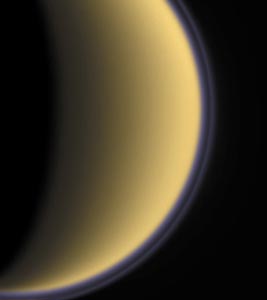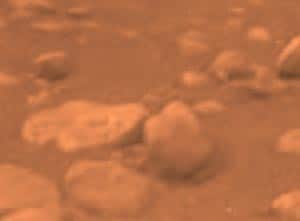Data from Europe's Huygens probe are revealing fascinating new information about Saturn's largest moon, as Jean-Pierre Lebreton explains

On 14 January last year a small probe called Huygens was ejected from its mother ship Cassini and began descending, slowed by parachutes, through the thick haze surrounding Titan – Saturn’s largest moon. During its two and a half hour journey before landing on Titan’s surface, the probe began collecting data that were immediately beamed back to Earth.
Planetary scientists eagerly began studying this information, which has now revealed to us an extraordinary world. Titan, it turns out, has many similarities to Earth; in particular, on Titan methane plays the role of water on our planet. Our exploration of this mysterious moon may therefore provide clues to the chemical and meteorological processes occurring here on Earth.
The outstanding success of the Cassini-Huygens mission has been the culmination of 25 years of effort by a successful international partnership between space scientists from Europe and the US. The mission was first proposed in the early 1980s, shortly after NASA’s Voyager probe beamed back the first observations of Titan. At first, those images were quite frustrating because they showed an almost featureless globe, obscured by a thick organic haze that veiled the moon’s surface.
But Voyager’s measurements of the infrared light reflected from Titan later revealed that a rich and complex organic chemistry is, in fact, at work in Titan’s atmosphere. Researchers then postulated that chemical reactions might be taking place on Titan that are similar to those that occurred on Earth before the development of life. To find out, the idea began to emerge of sending a spacecraft (Cassini) that could explore Saturn and then drop a probe (Huygens) to study Titan’s atmosphere in situ.
The design of the Cassini-Huygens mission started in 1982 and the craft was launched 15 years later in October 1997. After a seven-year journey across the solar system, it successfully entered into orbit around Saturn in July 2004, before Cassini released the Huygens probe on 25 December 2004. Three weeks later, the probe entered Titan’s atmosphere and began descending towards the moon’s surface. It was the most distant landing ever of a man-made craft on a moon of the outer solar system.
Huygens continued to operate on the surface for several hours, which was a pleasant surprise to all those involved in the mission. The data obtained by the probe – as it entered the atmosphere, descended and then sat on the surface – have provided us with a rich harvest of scientific information about Titan. After months of hard work, the hundred or so scientists working on the Huygens mission have now published a series of seven co-ordinated papers (Nature 438 758-802). The detailed in situ Huygens data beautifully complement the impressive data acquired by Cassini while flying past Titan on several occasions since the summer of 2004.
Titan’s surface mysteries unveiled
Larger than the planet Mercury, Titan is a world massive enough and cold enough to have an atmosphere that is mostly nitrogen and 10 times denser than that of the Earth. As the Voyager mission discovered, the temperature on the surface is a chilly -179 °C, a value that was confirmed by the Huygens Atmospheric Structure Instrument (HASI) built by Marcello Fulchignoni from the Observatoire de Paris and colleagues. The water on the surface of Titan is therefore frozen and cannot provide any oxygen for the atmosphere.
Hydrogen-rich conditions have existed on Titan for billions of years, and – in contrast to Earth – the dominant carbon-carrying gas is not carbon dioxide (CO2) but methane (CH4). In this atmosphere, the methane is destroyed by chemical reactions that create a series of complex carbon-containing organic molecules. These form thick layers of organic “haze” that pervade the whole atmosphere right down to the surface of Titan, where the material accumulates.
This haze is what initially prevented Voyager’s camera from viewing the surface at visible wavelengths all those years ago. But when the Huygens probe was first designed in the mid-1980s, no-one knew what the surface of Titan was actually like. Huygens was therefore equipped with an array of sensors to allow planetary scientists to carry out a unique in situ exploration of the structure, dynamics and composition of the atmosphere using various different techniques.
The composition of the particles in the haze has now been measured using two different instruments – the Aerosol Collector and Pyrolyser (ACP) built by a group of scientists led by Guy Israel from the CNRS Service d’Astronomie at Verrieres-le-Buisson near Paris, and the Gas Chromatograph and Mass Spectrometer (GCMS) built by Hasso Niemann’s group at NASA’s Goddard Space Flight Center in Maryland. Meanwhile, the physical and optical properties of the particles have been recorded by Huygens’ Descent Image Spectral Radiometer (DISR), which was built by Martin Tomasko from the University of Arizona and colleagues.
Although Huygens could only observe clear views of the surface when it had descended to within 50 km of touchdown, the images taken by the DISR have revealed river networks cut into an icy landscape. In the past, these rivers were filled with methane, which exists as a liquid in the cold conditions on Titan’s surface, although on the day of Huygens’ arrival, none was found. We can see that the rivers converge at a coastline and flow into what seems to be a further, large river-bed or lake-bed of water-ice material washed away by rain, and organic matter that falls from the sky.
Indeed, Huygens actually landed on a bed of such matter, which appears to have the consistency of wet sand. Moreover, shortly after touchdown, Niemann’s GCMS instrument found signs of methane evaporating from the surface, which indicates that this compound exists in Titan’s soil. Images taken after landing revealed a field of ice cobbles and pebbles.
An instrument on board the Cassini mother craft, known as the Imaging Science Subsystem (ISS), was designed to take pictures of Titan with a resolution in theory of 10 m as it occasionally flies past the moon at a distance of 1000 km from the surface. Although the ISS obtained some extraordinary images, the haze that shrouds Titan limited the actual resolutions to 1 km – roughly the same as that of the two other imaging instruments on board Cassini, the Visual and Mapping Infrared Spectrometer (VIMS) and the Radio Detection and Ranging (RADAR) instrument.
In contrast, the DISR instrument on board Huygens has been able to obtain images with a resolution of just 1 m at an altitude of 10 km and to better than 1 cm after landing. Unfortunately, researchers have not yet had time to compare in detail the images taken by Huygens with those from Cassini at different spatial resolutions and wavelengths. This process will take a few more months, but, when completed, will provide a unique understanding of Titan’s surface around the Huygens landing site and of the properties of the atmospheric haze. In fact, we will have to wait until spring 2008 before the RADAR instrument on board Cassini delivers its sharpest images of the Huygens landing site – and even then they will only have a resolution of about 300 m.
Up in the atmosphere
The Huygens probe has also enabled us to learn more about Titan’s upper atmosphere. Fulchignoni’s HASI instrument made a unique series of measurements of how the friction between Huygens and the air in the atmosphere slowed the probe as it descended from 1400 km above the surface to just 155 km. From this information, we calculated that the temperature in different parts of the atmosphere can vary by as much as 20 K within the space of just a few tens of kilometres. This indicates that Titan’s atmosphere is highly layered. Layering was also observed by Cassini’s ISS instrument.
Three instruments – the DISR, HASI and the Doppler Wind Experiment built by Michael Bird from the University of Bonn, Germany – have provided information about the basic physical properties of the atmosphere below about 155 km, at which point Huygens’ parachutes were deployed to slow its descent before landing on the surface. The temperature and pressure profiles obtained by HASI match pretty well (within about 1 K) with those obtained by Voyager.
However, Huygens revealed some startling information about Titan’s winds. At altitudes above 120 km, the winds move at speeds of 450 km h-1, but Bird’s instrument discovered there is also a “low wind” layer at an altitude of about 70-100 km. This layer had not been predicted following the Voyager mission, which suggests that Titan’s wind pattern is far more complex than we ever thought. The HASI device also found an unexpected region above and below the low-wind layer that generates a shear force. Titan’s meteorologists can not yet explain this mystery.
Fulchignoni’s instrument also confirmed that Titan’s atmosphere has a highly conducting layer at an altitude of about 60 km, where the gases are ionized by cosmic rays. Another interesting finding is that although Titan’s winds blow from west to east (i.e. in the same direction as the planet rotates, as predicted by circulation models), they travel in the opposite direction in the first 7 km above the surface. Both instruments found that these surface winds move at speeds of about 1 m s-1. Could these winds, which are moving at relatively low altitudes by Earth standards, be responsible for the wind-induced features on Titan?
More surprises
Since the days of Voyager, we have known that nitrogen gas (N2) is the most abundant component of Titan’s atmosphere. This fact has now been confirmed by Niemann’s GCMS instrument. It has also been able to measure how nitrogen and methane – the next most common constituent – vary with height in the atmosphere. It turns out that the proportion of methane increases from about 1.5% in the stratosphere to about 5% near the surface.
But where does the nitrogen come from? Nitrogen has two isotopes – N-14 and N-15 – and we would normally expect to see them in a ratio of about 97:3. However, measurements reveal an unusually low proportion of nitrogen-14 atoms in Titan’s atmosphere, which indicates that this isotope has been continually escaping from Titan’s grip over its entire history. The nitrogen probably came from ammonia (NH3) trapped in primordial ice that existed before Saturn was born.
In contrast, carbon – mostly present in the form of methane – does not show a strongly anomalous isotopic ratio. The methane, which is continuously destroyed by photochemical reactions, must therefore be regularly or episodically replenished in the atmosphere. Where this methane comes from remains a mystery. One theory is that it exists somewhere below ground and is brought to the surface by some form of volcano. This suggestion is bolstered by the fact that Huygens has detected argon-40 gas, which can only be produced when potassium in Titan’s rocky interior undergoes radioactive decay.
Meanwhile, the ACP instrument has successfully captured two samples of aerosols as the probe descended towards Titan’s surface. The samples were heated in an oven to a temperature of 600 °C and the products of the reaction were monitored both by the ACP itself and by the GCMS. A preliminary analysis of the spectra – complemented by lab tests carried out by Francois Raulin at the Université Paris-12 – indicates the presence of nitrogen-containing organic compounds in the core of the aerosol particles. Although further lab experiments will still be needed to determine the complexity of the compounds, these initial findings should let us predict the composition of organic matter on Titan’s surface as the aerosols in the atmosphere fall as “rain” to the surface.
Huygens is also equipped with a penetrometer – part of the Surface Science Package built by John Zarnecki of the Open University in the UK. It is essentially a spring-loaded stick pointing out from the bottom of the probe that can poke into the surface and measure the resistance it meets. This instrument clearly indicated that Huygens landed on some form of soft material with roughly the consistency of wet sand – probably a mixture of ice grains, organic matter and liquid. Measurements by Niemann’s spectrometer suggest that the liquid is, in fact, condensed methane.
Meanwhile, as Huygens approached Titan, the DISR instrument measured how light from an onboard lamp reflected from the surface. It confirmed that the concentration of methane is about 5% and showed that the surface consists of water ice, various known organic molecules such as tholins, as well as an additional, unknown component. Bernard Schmitt and colleagues at the Université Joseph Fourier in Grenoble, France, are currently carrying out experiments to identify this mysterious substance, which seems unlike any other we have ever seen in the solar system.
The work goes on
Huygens measurements, which are far from being fully analysed, so far confirm that Titan is indeed a unique body in the solar system. But this is just the start. Further analysis of the data – together with computer simulations, lab experiments and data from Cassini – should tell use even more about Saturn’s mysterious moon. Cassini-Huygens has turned out to be a wonderful mission and a massively successful story of international collaboration. Hopefully, it will be a model for further missions to Titan and to other parts of the solar system as well.





